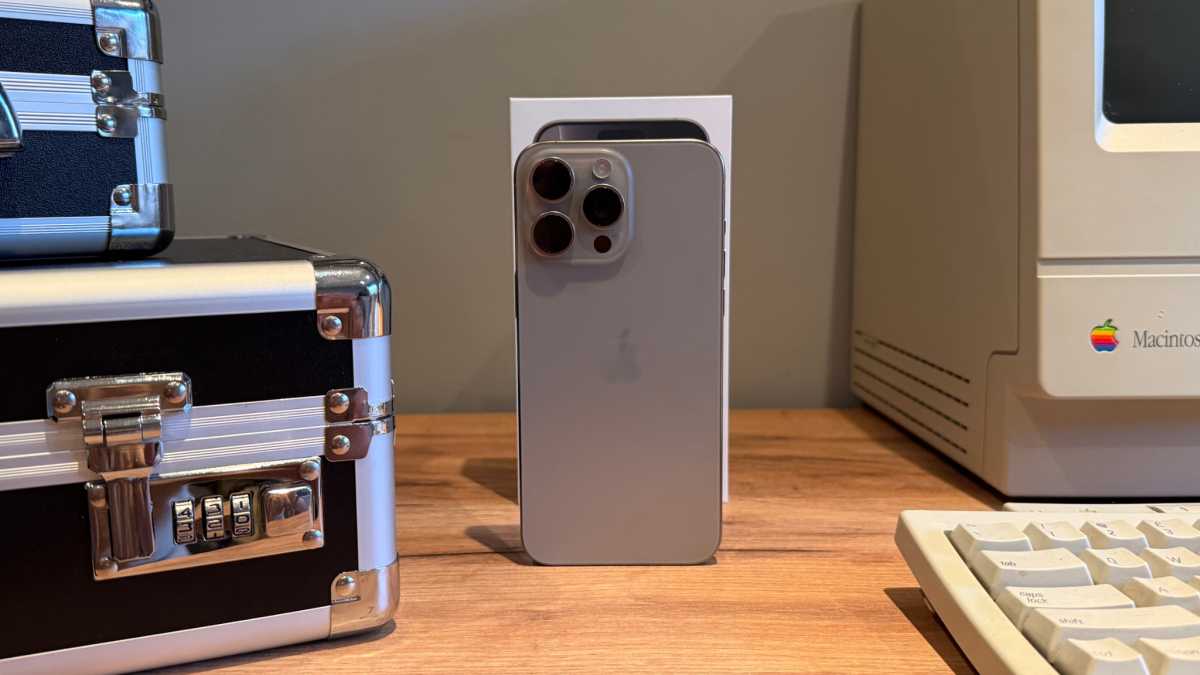As I write this, President Trump has instituted a minimum 10 percent tariff on virtually all imports, with imports from other countries seeing significantly higher rates. Of note, China and India, both huge final assembly hubs for Apple, have been targeted with a 34 percent and 26 percent tariff, respectively. The blanket 10 percent tariffs are in effect now, and the higher rates for individual countries, so-called “reciprocal tariffs” because they conflate trade imbalance with tariffs, go into effect on April 9.
Everyone is freaking out about this, and with good reason. The move has already crashed stock markets around the world, and for consumers in the United States, it’s going to make most of what we buy much more expensive. For example, the 34 percent China tariff is on top of the 20 percent tariff already in place, bringing the total to 54 percent.
It’s a fluid and evolving situation—China announced its intention to match Trump’s new 34 percent tariffs with its own, and just hours before this story was published Trump threatened to add an additional 50 percent tariff on Chinese imports if they don’t back off by April 8. Here’s what we know, and don’t know, about what the Trump tariffs are going to do to the price of Apple products.
What are tariffs?
Macworld isn’t a business or economics site, but we should briefly explain how tariffs work. The president has repeatedly claimed that other countries pay tariffs, which is not true. A tariff is a tax paid by the importer on goods that come from another country.
When Apple ships a plane or ship full of iPhones into the United States from the Foxconn plants in Shenzhen, China, it is held in customs until Apple pays the U.S. government a tax equal to 54 percent of the declared value of those products when the new tariffs take effect. Therefore, if the iPhone 16 you buy for $799 has a declared value of $500 (a reasonable guess considering Apple’s historically high margins), Apple would pay a tariff of $270 per iPhone 16.
Small tariffs are sometimes absorbed by the importing company, reducing its profits instead of raising prices for consumers. With larger tariffs, there is typically no choice but to pass some or all of the cost onto the consumer.
How much more will Apple devices cost?
The big question, then, is what will Apple products cost when the Trump tariffs take effect, both for the rest of 2025 and the longer term?
Truthfully, we don’t exactly know. Apple manufactures many of its products in China, using parts that are produced all over the world (including some in the United States). India is another popular production hub—Apple had previously set its sights on increasing the number of iPhones produced in India to 30 million by the end of this year. It’s a fraction of what is produced in China, but it’s a start.

The iPhone could end up costing a lot more due to tariffs.
Connor Jewiss / Foundry
The math about how much more it will cost Apple to bring any one product into the U.S. is complicated, to say the least. It’s safe to assume that this will add hundreds of dollars to the cost of Apple bringing an iPhone, Mac, or similar expensive items to U.S. customers. Other products won’t get off easy either. Apple has 35 suppliers and producers in Vietnam, where it manufactures everything from AirPods to iPads and Apple Watches. Trump’s tariff on imports from Vietnam is set at 46 percent.
We have seen some truly shocking estimates for what Apple products might cost. A Reuters article cites analysts at Rosenblatt Securities in claiming that iPhones and Apple Watches would need to be 43 percent more expensive to cover the cost of the tariffs. That makes the $799 iPhone 16 cost $1,142 while the $999 iPhone 16 Pro jumps to $1,429. The Apple Watch Series 10 would start at $570 instead of $399.
Price increases this big are unlikely, as it would entirely kill demand. Apple will press its suppliers for better prices, though the company already famously negotiates tight margins from its suppliers so there’s probably not a lot of room there. But Apple’s historically high margins give it some flexibility other companies might not have.
Together with Apple accepting lower margins on its products, it’s likely we will only see relatively modest price increases in the short term. Apple famously takes very big margins on components like RAM and storage, so there’s some room for Apple to pay most of the tariff cost and remain profitable (though much less so).
UBS analysts say the price of the iPhone 16 Pro Max would shoot up about $350, going from $1,199 to $1,549. Shifting production to India might reduce the increase from 30 percent to around 12-15 percent, but it should be noted that there isn’t nearly enough production capacity in India to make all U.S.-bound iPhones there.

Even the AirPods could see a significant price increase due to tariffs.
Foundry
We think it’s more probable that the iPhone 16 may jump from $799 to $849 or $899, but a jump all the way up to $1,100+ seems unlikely. AirPods Pro 2 may go up from $249 to $279, rather than balloon to $340+. More significant price jumps may be reserved for newer products launching in the fall: The iPhone 17 Air is already expected to have a higher price tag, but the rest of the iPhone 17 line, AirPods Pro 3, M5 Macs, and other products released later this year could have starting prices 20 percent higher or more.
Morgan Stanley analyst Erik Woodring said he expects overall price increases for Apple products in the 17-18 percent range in the short term. Apple has yet to comment on the tariffs or its prices in reaction to them.
Can Apple move production and assembly to the United States?
The stated goal of Trump’s tariffs is to force manufacturing back into the United States. Could Apple start building iPhones, Apple Watches, AirPods, Macs, and other products in the U.S.? After all, Apple manufactures the Mac Pro in Texas, right?
The answer is yes, but it’s a more complicated, lengthy, and expensive process than you might imagine. And it’s certainly not one that can happen quickly.

Apple may be able to shift some manufacturing to avoid the largest tariffs, but its production lines are too complex to change all at once.
Thomas Bergbold
First, there are labor costs. The workers who assemble iPhones at Foxconn’s facilities in China make less than $3 an hour, and it takes over a dozen hours of work to complete iPhone assembly and testing. If all other costs were equal, the difference in labor costs alone—even if the U.S. workers made a terrible $10 an hour—would inflate the cost of making an iPhone by at least $100 or more.
But that is the least of the reasons why iPhones, Apple Watches, MacBooks, and many other Apple products cannot be built here anytime soon. At the Fortune Global Forum in China way back in 2017, Tim Cook explained why the company leans so heavily on Chinese manufacturing:
The popular conception is that companies come to China because of low labor cost. I’m not sure what part of China they go to but the truth is China stopped being the low labor cost country many years ago and that is not the reason to come to China from a supply point of view.
The reason is because of the skill, and the quantity of skill in one location, and the type of skill it is. The products we do require really advanced tooling. And the precision that you have to have in tooling and working with the materials that we do are state-of-the-art. And the tooling skill is very deep here [in China]. In the U.S. you could have a meeting of tooling engineers and I’m not sure we could fill the room. In China, you could fill multiple football fields. That vocational expertise is very very deep here.
Not much has changed in that regard in the eight years since Cook made that comment. Manufacturing iPhones, iPads, AirPods, or Apple Watches in the tens of millions requires very advanced factories that don’t exist here, tooling and machining work that is in short supply in the United States, and a massive manufacturing labor force with training in the sort of extreme precision required.

We don’t know what effect tariffs will have on Apple devices, but Apple will likely pass some costs onto consumers.
Petter Ahrnstedt
If Apple were to make every effort to build the iPhone in the United States, it would take at least 3-5 years to build and staff the manufacturing plants—and that’s with all the necessary zoning, permits, regulations, environmental review, and other red tape fast-tracked in a way it never has been before. Training the tooling and manufacturing experts to create the necessary workers to fill these factories would also take several years, and that’s if there were tens of thousands of people beginning such education and training today.
The high-precision, high-volume manufacturing Apple requires has been a concerted effort in southeast Asia for decades and it would take many years for the United States to catch up. Even if Apple were to assemble iPhones and other products in the U.S., they are made from parts that are built all over the world: flash storage from Kyoxia in Japan, displays from Samsung or LG in Korea, RAM from SK Hynix in Korea, main processors from TSMC in Taiwan, and so on.
These parts would be subject to tariffs as they’re brought into the U.S. to be built into iPhones. Avoiding tariffs would mean those foreign companies would have to build and staff advanced manufacturing facilities in the U.S. as well, which would also take years. In addition, all of this production onshoring would come with huge capital expenditures and training/education costs that must be recouped.
A rapidly evolving situation
The tariff outlook has changed multiple times in just the five days since President Trump announced his “reciprocal” tariffs, with international markets reacting, other countries promising to raise tariffs on the U.S., congress arguing about reclaiming its tariff authority, Trump threatening to raise tariffs on China even higher, and more.
For a variety of reasons, this situation will probably not remain stable. It may have changed by the time you read this. Steep tariffs may be with us for weeks, or months, or years. Exceptions might be negotiated for individual countries, industries, or individual companies.
With this much uncertainty for the months ahead, it’s almost impossible to predict the pricing outcomes for Apple’s current and future products, except to say that the tariffs as announced will incur a massive financial cost to Apple that they will almost certainly pass on to customers (at least in part), and that fully onshoring most of the company’s most popular products is a lengthy and expensive process of its own.
So if you’re looking to get a new MacBook, iPhone, or Apple Watch, we recommend making the decision sooner than later.




